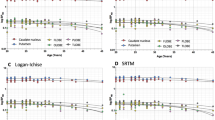Abstract
The contribution of differential absorption-distribution pharmacokinetics to drug activity can be partially determined by comparing simultaneous estimates of drug serum level with pharmacodynamic effects. In the present paper we have contrasted the effects of clinically equipotent doses of lorazepam, alprazolam, and diazepam on the performance of tracking and digit symbol substitution tasks. Eight young males were tested for 12 h after ingesting the drug. The three benzodiazepines and placebo were administered to each subject according to a balanced double-blind Latin square design. A model is presented that describes the relationship between drug concentration and the degree of impairment across time after the final peak effect. Exponential rate constants were determined for each drug using a Marquardt nonlinear fit of the pooled data. Basically, the constants relate offset serum drug values to the impairment curves at a time when serum-brain equilibrium is assumed to have occurred. The values indicate markedly rapid acute tolerance for alprazolam and diazepam but relatively little acute tolerance for lorazepam. Whether these constants reflect adaptation or differential association-dissociation receptor rate constants cannot be determined, but they do highlight the need to consider receptor kinetics as an important factor in benzodiazepine pharmacodynamics.
Similar content being viewed by others
References
Arendt RM, Greenbaltt DJ, DeJong RH, Bonin JD, Abernethy DR, Ehrenberg BL, Gwynne Giles H, Sellers EM, Shader RI (1983) In vitro correlates of benzodiazepine cerebrospinal fluid uptake, pharmacodynamic action and peripheral distribution. J Pharmacol Exp Ther 227:98–106
Braestrup C, Nielsen M (1983) Benzodiazepine receptors. In: Iversen LL, Iversen SD, Snyder SH (eds) Handbook of psychopharmacology: Biochemical studies of CNS receptors. Plenum, New York, pp 285–384
Chiu TH, Rosenberg AC (1982) Comparison of the kinetics of [H-3]-labeled diazepam and [H-3]-labeled flunitrazepam binding to cortical synaptosomal membranes. J Neurochem 39:1716–1725
Dubnick B, Lippa AS, Klepner CA, Coupet J, Greenblatt EN, Beer B (1983) The separation of 3H-benzodiazepine binding sites in brain and of benzodiazepine pharmacological properties. Pharmacol Biochem Behav 13:311–318
Ellinwood EH Jr, Linnoila M, Easler ME, Molter DW (1983a) Profile of acute tolerance to three sedative anxiolytics. Psychopharmacology 79:137–141
Ellinwood EH Jr, Easler ME, Linnoila M, Molter DW, Heatherly DG, Bjornsson TD (1983b) Effects of oral contraceptives on diazepam-induced impairment of psychomotor activity in young females. Clin Pharmacol Ther 35:360–366
Gee KW, Yamamura HI (1982) Benzodiazepine receptor heterogeneity: A consequence of multiple conformational states of a single receptor or multiple population of structurally distinct macromolecules. In: Usdin E (ed) Pharmacology of the benzodiazepines. MacMillan, New York, pp 93–108
George KA, Dundee JW (1977) Relative amnesic actions of diazepam, flunitrazepam and lorazepam in man. Br J Clin Pharmacol 4:45–50
Gibaldi M, Perrier D (1975) Pharmacokinetics. Dekker, New York
Greenblatt DJ, Franke K, Shader RI (1978) Analysis of lorazepam and its glucuronide metabolite by electron-capture gas-liquid chromatography. J Chromatogr 146:311–320
Greenblatt DJ, Ochs HR, Lloyd BL (1980) Entry of diazepam and its major metabolite into cerebrospinal fluid. Psychopharmacology 70:89–93
Greenbaltt DJ, Divoll M, Moschitto LJ, Shader RI (1981) Electron-capture gas chromatographic analysis of the triazolobenzodiazepines, alprazolam and triazolam. J Chromatogr 225:202–207
Greenblatt DJ, Divoll M, Abernethy DR, Ochs HR, Shader RI (1983) Clinical pharmacokinetics of the newer benzodiazepines. Clin Pharmacokinet 8:233–252
Holford NH, Sheiner LB (1981) Pharmacokinetic and pharmacodynamic modeling in vivo. Crit Rev Biomed Eng 5:273–322
Jack ML, Corborn WA, Spirt NM, Bautz G, Zanki M, Horst W, O'Brien RA (1983) A pharmacokinetic/pharmacodynamic receptor binding model to predict the onset and duration of pharmacological activity of the benzodiazepines. Prog Neuropsychopharmacol Biol Psychiatry 7:5–6
Johnson RF, Schenker RK, Roberts RK, Desmond PV, Wilkinson GR (1979) Plasma binding of benzodiazepines in humans. J Pharm Sci 68:1320–1322
Kaplan SA, Jack ML (1983) Metabolism of the benzodiazepines: Pharmacokinetic, and pharmacodynamic considerations. In: Costa E (ed) Benzodiazepines: From molecular biology to clinical practice. Raven, New York, pp 173–199
Lo MMS, Trifelleti RR, Snyder SH (1982) Physical separation and characterization of two central benzodiazepine receptors. In: Usdin E (ed) Pharmacology of the benzodiazepines. MacMillan, New York, pp 165–173
MacLeod SM, Giles HG, Patzalek G, Thiessen JJ, Sellers EM (1977) Diazepam actions and plasma concentrations following ethanol ingestion. Eur J Clin Pharmacol 11:345–349
Palva ES, Linnoila M (1978) Effect of active metabolites of chlordiazepoxide and diazepam, alone or in combination with alcohol, on psychomotor skills related to driving. Eur J Clin Pharmacol 13:345–350
Reeves PM, Schweizer MP (1983) Aging, diazepam exposure and benzodiazepine receptors in rat cortex. Brain Res 270:376–379
Seppala T, Leino T, Linnoila M, Huttunen M, Ylikahri R (1976) Effects of hangover on psychomotor skills related to driving: Modification by fructose and glucose. Acta Pharmacol Toxicol 38:209–218
Skinner TJ III (1979) A very sensitive gas chromatographic analytical procedure for the amitriptyline and nortriptyline tricyclic antidepressants. MS Thesis, Department of Pharmacology, University of North Carolina, Chapel Hill
Squires RF, Benson D, Braestrup C, Coupet J, Klepner CA, Myers V, Beer B (1979) Some properties of brain specific benzodiazepine receptors. Pharmacol Biochem Behav 10:825–830
Author information
Authors and Affiliations
Rights and permissions
About this article
Cite this article
Ellinwood, E.H., Heatherly, D.G., Nikaido, A.M. et al. Comparative pharmacokinetics and pharmacodynamics of lorazepam, alprazolam and diazepam. Psychopharmacology 86, 392–399 (1985). https://doi.org/10.1007/BF00427897
Received:
Accepted:
Issue Date:
DOI: https://doi.org/10.1007/BF00427897




